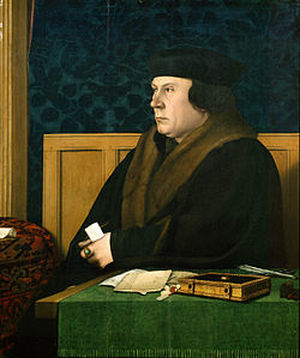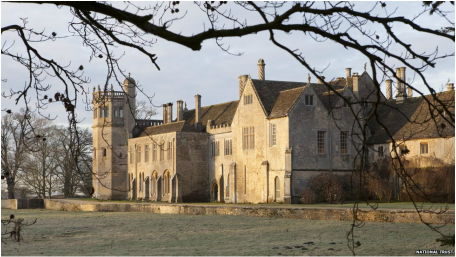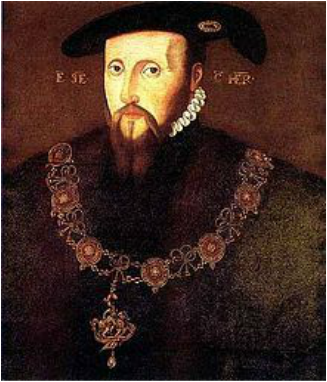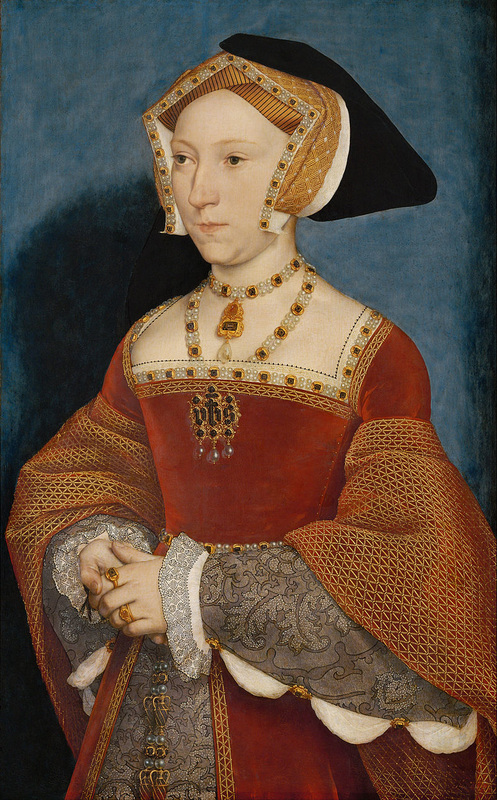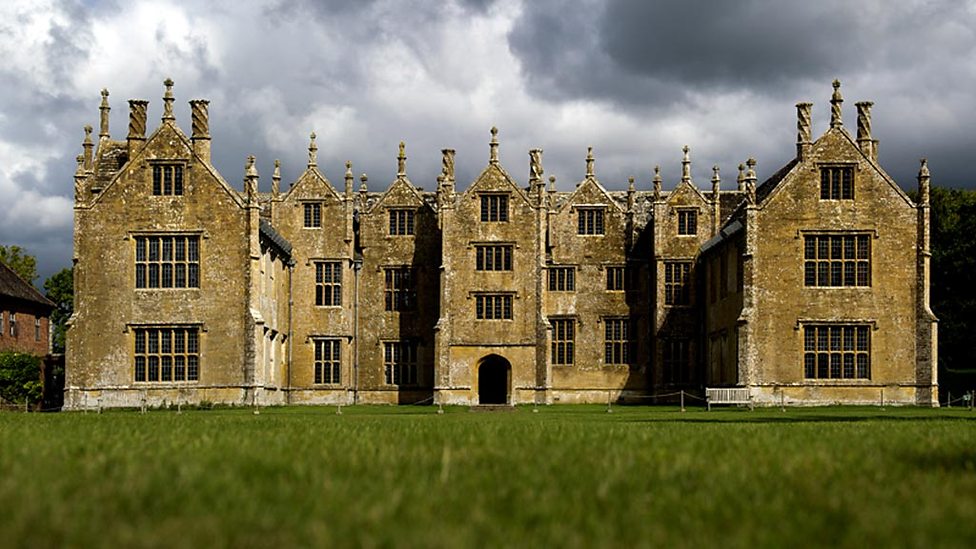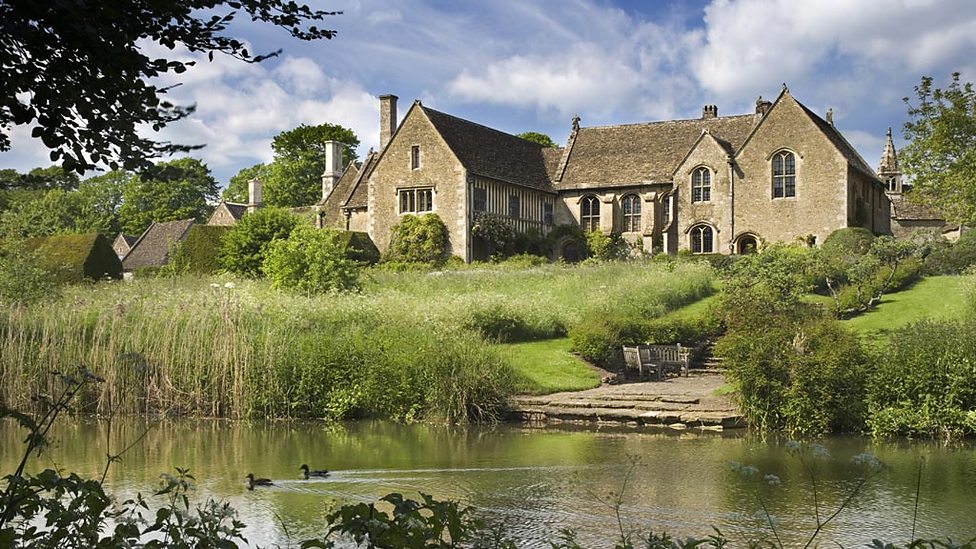|
Wolf Hall and Box
Researched by Verity Jeffery October 2016 Many of us enjoyed the television adaptation of Hilary Mantel's novels. The programmes were largely filmed at Wells Cathedral, Montacute House and Barrington Court; and, more locally, at Lacock Abbey, Great Chalfield and Bradford-on-Avon. Few know that the Seymour family of Wolf Hall, Savernake, were related to a prominent Box family. Left: Hans Holbein's painting of Thomas Cromwell, original owner of Wolf Hall (courtesy Wikimedia Common) |
The connection came through Edward Seymour, who called himself the Protector Somerset. He was the regent during the minority of Edward VI, the successor to Henry VIII, and the developer of the Protestant Reformation in England. To understand the connection we need to go back to the start of the Tudor era.
Sir John Seymour, 1474 - 1536
Sir John Seymour, 1474 - 1536
|
Sir John was born at Wolf Hall, Savernake, and was a soldier and courtier to Henry VII and Henry VIII. He married Margaret Wentworth in 1494 and they had eight children, including Edward, born in 1506.Their other children included Thomas Baron Seymour who married Catherine Parr, widow of Henry VIII and Jane Seymour, third wife of King Henry and mother of the future Edward VI.
Right: Lacock Abbey was used extensively for filming (https://www.nationaltrust.org.uk/lacock-abbey-fox-talbot-museum-and-village) |
Sir John was a very important person in Wiltshire rising from local potentate to royal courtier. He was three times appointed Sheriff of Wiltshire and also Sheriff of Somerset and Dorset, Justice of the Peace for Wiltshire and Warden of Savernake Forest. In 1509 he became Knight of the Body (royal bodyguard sleeping outside king's chamber) and later Constable and Door Ward of Bristol Castle and Groom of the Bedchamber in 1532.
|
Descendants of Edward Seymour,
First Duke of Somerset, 1506 - 1552 Edward, the eldest child of Sir John and Margaret, was the famous Lord Protector of the child king, Edward VI, who was his nephew by Jane Seymour. He was the most influential person in the country from 1547 to 1552 and the person who arguably did most to introduce Protestantism to England until his fall from grace and execution in 1552. Following the Lord Protector we have a succession of children called Edward Seymour. The Lord Protector's son Lord Edward Seymour (1528 - 1593) was Sheriff of Devon, knighted by his father on the battlefield of Pinkey Cleugh and holder of the castle and manor of Berry Pomeroy, Devon. His only son, Sir Edward Seymour (1563 - 1613), married Elizabeth Champernowne (1555 - 1613). Left: Lord Protector Edward Seymour, unknown artist (Marquess of Bath collection) |
It was a marriage arranged by their parents; Sir Edward was only thirteen when he married in 1576 at Dartington and had been betrothed to Elizabeth for ten years already. As always money was involved as the Champernownes were the owners of Dartington Hall, Devon, for 366 years until 1926. Mary Seymour (1580 - 1661) was their third child.
|
Maternal Succession
We need to go through several maternal lines at this point. Lady Mary Seymour (1580 - 1661) married Sir George Farewell (1579 - 1647) in 1610. They continued the royal connections and Sir George was the eleven times great grandfather to Lady Diana Spencer so naturally to Prince William and his heirs. One of their thirteen children was Margaret Farewell (1617 - 1672) who married John Ralf (1605 - 1664) and whose youngest daughter, Brigit (1641 - 1698) is our connection. Brigit Ralph (1641 - 1698) married Charles Buckland (1627 - 1699) and they had a child Mary Buckland (1667 - 1743). The Buckland family were prominent local people who leased Gurney Court from the Duchy of Cornwall. One relative, Ralph Buckland (1564 - 1611), was a celebrated Puritan in the reign of James I who later became a Catholic priest and it is rumoured may have taken part in the Gunpowder Plot. Right: Jane Seymour by Hans Holbein (Wikimedia Common) |
The Goodhind Family of Saltford
The line goes through several generations of the Goodhind family at this point. John Goodhind (1661 - 1737) married Mary Buckland (1667 - 1743) and they had a child John (1700 - 1773). The third child of John Goodhind (1700 - 1773) and Ann Hazle (b 1702) was Thomas Goodhind (1730 - 1784) and we begin to close in on the Box connection. The family were non-conformist and Thomas was baptised in the Protestant Meeting House at Chelwood, near Chew Valley. Their second of thirteen children, Richard (1759 - 1812) was a butcher at Salford who married Sarah Hill and it was their child, Elizabeth (Betty) who is the direct link.
The Goodhinds were wealthy. For three generations they owned Salford Manor, thought to be the oldest house in Somerset. They were related by marriage to Sir John Harrington, godson of Queen Elizabeth I and husband of an illegitimate daughter of Henry VIII.
The line goes through several generations of the Goodhind family at this point. John Goodhind (1661 - 1737) married Mary Buckland (1667 - 1743) and they had a child John (1700 - 1773). The third child of John Goodhind (1700 - 1773) and Ann Hazle (b 1702) was Thomas Goodhind (1730 - 1784) and we begin to close in on the Box connection. The family were non-conformist and Thomas was baptised in the Protestant Meeting House at Chelwood, near Chew Valley. Their second of thirteen children, Richard (1759 - 1812) was a butcher at Salford who married Sarah Hill and it was their child, Elizabeth (Betty) who is the direct link.
The Goodhinds were wealthy. For three generations they owned Salford Manor, thought to be the oldest house in Somerset. They were related by marriage to Sir John Harrington, godson of Queen Elizabeth I and husband of an illegitimate daughter of Henry VIII.
James Goulstone, 1786 - 1834, and Betty Goodhind, 1784 - 1866
We finally begin to get to the start of Box's connection of these national families when James and Betty, both born in Saltford, married in 1806. They farmed at Saltford, Somerset. Their fifth child, Thomas (1818 - 1900), married Hannah Ann Waters and it was this couple who moved to Box in about 1865 to farm at Hill House Farm.[1]
To follow through on the history of the Goulstone Family in Box, please look at the fascinating article and photographs from Ainslie and Shirley Goulstone.
So the connection of the Goulstone family with royalty is complete, albeit rather tenuous at times. Well, who would have suspected this of cousins David and Ainslie Goulstone and John and Shirley Goulstone. This was only a bit of light-hearted fun so please modern Goulstones don't expect any curtseys when we next greet you.
We finally begin to get to the start of Box's connection of these national families when James and Betty, both born in Saltford, married in 1806. They farmed at Saltford, Somerset. Their fifth child, Thomas (1818 - 1900), married Hannah Ann Waters and it was this couple who moved to Box in about 1865 to farm at Hill House Farm.[1]
To follow through on the history of the Goulstone Family in Box, please look at the fascinating article and photographs from Ainslie and Shirley Goulstone.
So the connection of the Goulstone family with royalty is complete, albeit rather tenuous at times. Well, who would have suspected this of cousins David and Ainslie Goulstone and John and Shirley Goulstone. This was only a bit of light-hearted fun so please modern Goulstones don't expect any curtseys when we next greet you.
